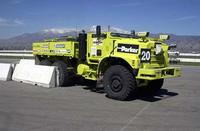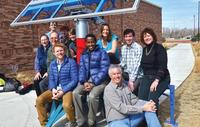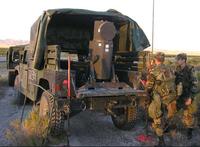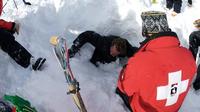-
New infrared technique remotely to detect dangerous materials
Researchers say that infrared technology holds the potential to spot from afar whether a site is being used to make nuclear weapons. They developed a model which precisely characterizes the material in each pixel of an image taken from a long-wave infrared camera. The U.S. National Nuclear Security Administration (NNSA) funded the project. The government’s long-term goal for infrared technology is remotely to detect the exact materials, chemicals and gases coming and going from factories or other sites suspected of illegal nuclear production.
-
-
DARPA Grand Challenge: Ten years on

At the break of dawn on 13 March 2004, fifteen vehicles left a starting gate in the desert outside of Barstow, California, to make history in the DARPA Grand Challenge, a first-of-its-kind race to foster the development of self-driving ground vehicles. It is not easy to quantify the effects of these DARPA challenges on the development and deployment of autonomous vehicle technology, but ten years later defense and commercial applications are proliferating. The rapid evolution of the technology and rules for how to deploy it are being driven by the information technology and automotive industries, academic and research institutions, the Defense Department and its contractors, and federal and state transportation agencies.
-
-
Innovative solar-powered toilet to be unveiled in India next week

Unsafe methods to capture and treat human waste result in serious health problems and death — food and water tainted with pathogens from fecal matter results in the deaths of roughly 700,000 children each year. A revolutionary toilet fueled by the sun is being developed by University of Colorado Boulder researchers to help some of the 2.5 billion people around the world lacking safe and sustainable sanitation. It will be unveiled in India this month.
-
-
Compact UV laser for biological, chemical detection

In addition to detecting chemical and biological agents in the field — or at home to protect against mass terror attacks — UV lasers have many other uses. The new class of UV lasers envisioned by DARPA’s Laser UV Sources for Tactical Efficient Raman (LUSTER) program is expected to be of use for a broad range of applications such as point-of-need medical diagnostics, advanced manufacturing, and compact atomic clocks.
-
-
Biometric security for mobile devices becoming mainstream
Biometric security such as fingerprint, face, and voice recognition is set to hit the mainstream as global technology companies market the systems as convenient and easy to use. The latest biometric technologies are not without their security issues, but they are marketed as more convenient than traditional methods rather than more secure, and encourage adoption by people who currently do not have any security on their phone at all.
-
-
Platform for operating systems would outwit cyber criminals
As smartphone use surges, consumers are just beginning to realize their devices are not quite as secure as they thought. A Swedish research team is working on a way to secure mobile operating systems so that consumers can be confident that their data is protected.
-
-
App helps save people trapped by avalanche

For the person buried under the weight of an avalanche, each minute is precious. A person saved from the snow mass within fifteen minutes has a 90 percent chance of survival. After forty-five minutes that chance has diminished considerably. Researchers develop an app that makes it possible for skiers with smartphones to find people buried in the snow.
-
-
Virtual lab for nuclear waste repository research
A nuclear waste repository must seal in radioactive waste safely for one million years. Researchers currently have to study repositories and their processes in real underground laboratories, but a virtual underground laboratory will soon simplify their work.
-
-
Unsupervised robotic construction crew to build flood defenses
On the plains of Namibia, millions of tiny termites are building a mound of soil — an 8-foot-tall “lung” for their underground nest. They do so without a supervisor, foreman, or CEO to tell them what to do. During a year of construction, many termites will live and die, wind and rain will erode the structure, and yet the colony’s life-sustaining project will continue. Harvard researchers, inspired by the termites’ resilience and collective intelligence, have created an autonomous robotic construction crew. The system needs no supervisor, no eye in the sky, and no communication: just simple robots — any number of robots — that cooperate by modifying their environment. In the future, similar robots could lay sandbags in advance of a flood, or perform simple construction tasks on Mars.
-
-
Remote explosives detection may see the end of full-body scanners
Standing in a full-body scanner at an airport is not fun, and the process adds time and stress to a journey. It also raises privacy concerns. Researchers now report a more precise and direct method for using terahertz (THz) technology to detect explosives from greater distances. The advance could ultimately lead to detectors that survey a wider area of an airport without the need for full-body scanners.
-
-
Advancing algae’s viability as a biofuel
Lab success does not always translate to real-world success. A team of scientists, however, has invented a new technology that increases the odds of helping algae-based biofuels cross that gap and come closer to reality. The current issue of Algal Research showcases the team’s invention — the environmental photobioreactor. The ePBR system is the world’s first standard algae growing platform, one that simulates dynamic natural environments.
-
-
Countering counterfeit electronic components
Used and non-authentic counterfeit electronic components are widespread throughout the defense supply chain; over the past two years alone, more than one million suspect parts have been associated with known supply chain compromises. In the military, a malfunction of a single part could lead to system failures that can put soldier lives and missions at risk. A new DARPA program seeks tool that authenticates electronic components at any step of the supply chain.
-
-
Sandia Lab leading multidisciplinary effort to counter WMD
Threats of terrorism and weapons of mass destruction do not seem as imminent today as they did after the 9/11 attacks, but Jill Hruby, vice president of International, Homeland, and Nuclear Security at Sandia Labs, says that scientists, industry, and universities working on technological solutions to national security challenges must anticipate what could come next. Speaking at AAAS annual meeting, Hruby said that in an environment of lower public interest — due, in part, to the success of early efforts to combat terrorism that resulted in fewer major incidents in recent years — continued collaboration between national security laboratories, academia, and industry is needed.
-
-
Sensors would spot structural weaknesses in bridges, stadiums before they collapse
A team of engineers, with a grant of $1 million from the government of Qatar, will work to develop a wireless sensor network which will monitor vibrations, sagging, and stresses to assess a structure’s ability to carry its load. The proposed system would not only detect damage after it occurs, but would aim to predict it before it takes place.
-
-
New technologies make police work more effective
Law enforcement officers across the country are adapting to new technologies which aim to improve efficiency and accuracy on the job. The average police car is now equipped with a laptop which provides access to national criminal databases, portable fingerprint scanners, Breathalyzer units, automatic license-plate-readers, and even printers that can print out a citation ticket. Experts stress that while technology has equipped law enforcement officers with sophisticated resources, officers must not abandon old-fashioned practices like maintaining a personal connection with the communities they serve.
-
More headlines
The long view
Autonomous Vehicle Technology Vulnerable to Road Object Spoofing and Vanishing Attacks
Researchers have demonstrated the potentially hazardous vulnerabilities associated with the technology called LiDAR, or Light Detection and Ranging, many autonomous vehicles use to navigate streets, roads and highways. The researchers have shown how to use lasers to fool LiDAR into “seeing” objects that are not present and missing those that are – deficiencies that can cause unwarranted and unsafe braking or collisions.
Tantalizing Method to Study Cyberdeterrence
Tantalus is unlike most war games because it is experimental instead of experiential — the immersive game differs by overlapping scientific rigor and quantitative assessment methods with the experimental sciences, and experimental war gaming provides insightful data for real-world cyberattacks.
Prototype Self-Service Screening System Unveiled
TSA and DHS S&T unveiled a prototype checkpoint technology, the self-service screening system, at Harry Reid International Airport (LAS) in Las Vegas, NV. The aim is to provide a near self-sufficient passenger screening process while enabling passengers to directly receive on-person alarm information and allow for the passenger self-resolution of those alarms.
Falling Space Debris: How High Is the Risk I'll Get Hit?
An International Space Station battery fell back to Earth and, luckily, splashed down harmlessly in the Atlantic. Should we have worried? Space debris reenters our atmosphere every week.
Testing Cutting-Edge Counter-Drone Technology
Drones have many positive applications, bad actors can use them for nefarious purposes. Two recent field demonstrations brought government, academia, and industry together to evaluate innovative counter-unmanned aircraft systems.
Strengthening the Grid’s ‘Backbone’ with Hydropower
Argonne-led studies investigate how hydropower could help add more clean energy to the grid, how it generates value as grids add more renewable energy, and how liner technology can improve hydropower efficiency.
The Tech Apocalypse Panic is Driven by AI Boosters, Military Tacticians, and Movies
From popular films like a War Games or The Terminator to a U.S. State Department-commissioned report on the security risk of weaponized AI, there has been a tremendous amount of hand wringing and nervousness about how so-called artificial intelligence might end up destroying the world. There is one easy way to avoid a lot of this and prevent a self-inflicted doomsday: don’t give computers the capability to launch devastating weapons.
The Tech Apocalypse Panic is Driven by AI Boosters, Military Tacticians, and Movies
From popular films like a War Games or The Terminator to a U.S. State Department-commissioned report on the security risk of weaponized AI, there has been a tremendous amount of hand wringing and nervousness about how so-called artificial intelligence might end up destroying the world. There is one easy way to avoid a lot of this and prevent a self-inflicted doomsday: don’t give computers the capability to launch devastating weapons.
